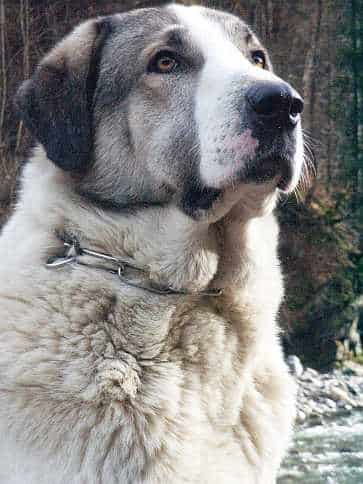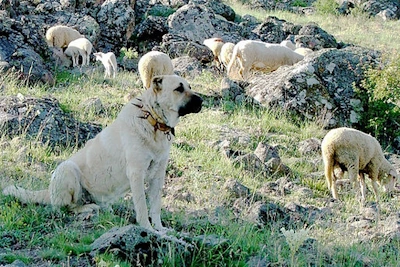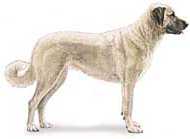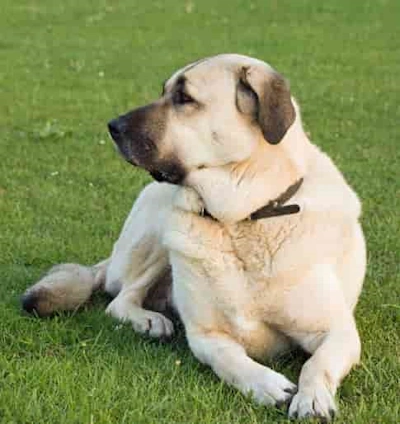Anatolian Shepherd Dogs
Anatolian Shepherd dogs, originating in rural Turkey, are actually known by a number of names, one being Karabash, which in Turkish translates to “Blackhead”.
 Courtesy Horst Peters
Courtesy Horst PetersThis talented guardian of flocks is believed by canine experts to have evolved from similar shepherd type breeds, dating back some 6,000 years, that protected livestock of sheep from common prey such as cheetahs, bears, jackals, and wolves.
With rising interest in contemporary herding dogs in the western world, breeders from the United States began conducting in-depth research regarding Anatolian Shepherd dogs and their origin.
To the best of their knowledge, it was found the most likely origin of this particular breed was the result of Akbash and Kangal breeds from Turkey where they are held in high esteem and value.
History of the Breed
Today, the Anatolian breed has become a popular choice specific to guarding flocks of sheep in North America due to the dog’s incredible hearing, visual and strength attributes as well as fearless demeanor.
Part of this popularity was triggered, when in 1973 the Endangered Species Act was passed which made it illegal to harm or kill livestock predators such as wolves, coyotes, bears, and mountain lions.
As a result, livestock guarding dogs were sought out to defend herds against predators by providing a formidable large presence as well as loud barking. This approach was quite successful in reducing livestock losses on ranches.
The protective heritage of the Anatolian, also referred to as a livestock guardian dog, has also made them a popular choice for guarding other vulnerable animals such as goats, alpacas,
ostriches,
chickens and even small dogs.
The Anatolian Shepherds were not in evidence in America until after
World War II and even then only minimally known. It wasn't until 1970
when the Anatolian Shepherd Dog Club of America was founded that they
received a much wider audience.
The American Kennel Club classified the Anatolian breed with the Working Dog Group in 1998 after it had temporarily been assigned to the miscellaneous group while awaiting full recognition.
The Anatolian's background includes some
colorful events as told in this very interesting story about the Secret History of Anatolian Shepherd Dogs.
 Kangal Courtesy Creative Commons
Kangal Courtesy Creative CommonsAppearance
Although a very large, strong, and rugged breed of dog, Anatolian Shepherds are also known for having a somewhat slender build, and surprisingly, tremendous agility.
Height: 27-29 inches
Weight: 80-150 lbs.

Coat Color: Most commonly the coat is seen in patterns of fawn, white cream, biscuit or white, but can be one solid color. Some dogs may also have a black mask and/or black ears. Coat colors of puppies may change significantly as they mature to adulthood.
As mentioned, Anatolian Shepherd dogs are large, often compared to the Great Pyrenees. Both male and female dogs are quite muscular, featuring broad heads and thickened necks although there are differences in actual size.
Typically, females stand
between 27 and 30 inches tall from the shoulder and weigh somewhere around 80 to 120 pounds while males stand between 26
and 31 inches tall and reach up to 150 pounds.
These weights may be reached by the end of their first year!
 Courtesy K. Arnold
Courtesy K. ArnoldCoat and Care
One of the unique features of the Anatolian Shepherd's coat is that while most are cream, this breed could be virtually any color
with colored spots of decent size that only cover approximately 30% of the dog’s body, a color combination called “piebald.”
Additionally, some dogs have black ears and mask while some do not. Based on the dog’s lineage, the coat would be of medium
or medium long length.
Like many shepherd type breeds, the Anatolian has a dense, double coat.
Because of this, extensive shedding is to be expected. Therefore,
anyone interested in this breed should be prepared to provide regular
grooming to keep the coat in good condition.
While the double coat provides protection for a working dog, it does tend to hold onto dead hair. Removing the loose hair keeps the coat healthier and avoids having the hair
pile up around the house.
Anatolian Shepherds also grow a thick band of
hair around the neck, which serves as a means of protection to the
throat, as well as thicker hair on the tail.
Use a slicker brush for the undercoat to prevent matting.
For de-shedding, a very exceptional grooming tool is the FURminator
.
Health of Anatolian Shepherd Dogs
Many large dog breeds only live to about 10 years of age but Anatolian Shepherd dogs usually lives to 12 years, often more.
However, being larger, this type of dog is prone to certain health concerns often associated with bigger breeds.
The most common include:
- Hip and Elbow Dysplasia, in which the hip and elbow joints respectively develop or grow abnormally,
- Osteocondrosis Dissecans, which involves some degree of separation of an area of cartilage from bone, and
- Hypertrophic Osteodystrophy, a bone disease that causes significant pain.
Along with these common health issues, this kind of shepherd would be at risk for:
- Panosteitis, also referred to as a “long bone disease” or “growing pains”,
- Anterior Cruciate Ligament Rupture whereby a knee ligament tears and becomes unstable,
- Entropion, a condition of the eyelid,
- Hypothyroidism, a thyroid gland disorder, and
- Epilepsy where the dog would have
recurring seizures.
among a few other minor conditions.
Although some health concerns simply go hand-in-hand with this dog breed, purchasing this specific kind of dog from a highly reputable breeder would certainly reduce potential problems.
Personality and Traits
People who have owned Anatolian Shepherd dogs would agree this breed comes with a unique personality.
Because herding is
such a huge part of the dog’s inner breeding, it is imperative to provide intense obedience training while still a puppy to
keep the alpha mentality in check, which typically includes stubbornness and issues with being territorial.
However, with
proper training, this dog would make an exceptional herder if so desired, and often a family pet.
In fact, not only are Anatolian Shepherd dogs usually loving, faithful, and gentle with family members, they make outstanding guard dogs.
How Active is The Anatolian?
By nature of the breed, a large outdoor area where the dog could play and work is mandatory. Since this breed is active,
unless being used to herd, it would be essential to provide this type of dog with daily workouts or other forms of physical
activity.
Without sufficient exercise, boredom and frustration could cause the
strong personality to come out in a negative or destructive
manner. For this reason, it is generally recommended only experienced
people own this breed, those qualified to offer
ongoing exercise, training, and especially socialization.
Ideal Living Space
If kept outdoors full-time, Anatolian Shepherd dogs need a large fenced-in area unless living on spacious private property
away from other homes.
If allowed indoors, whether part-time or full-time, this breed would also need room to roam. Again,
the most important consideration is providing this dog breed with daily exercise and/or stimulation.
The Anatolian With Children?
Dogs falling within this group of shepherds can do well with children, but because of the potential for dominance, as well
as large body size, this dog would be best suited in homes with older children, but also children taught the appropriate way
of handling a larger dog.
When brought into the home as a puppy, as long as training is provided and older children are
educated about proper animal care, the match would be good.
Otherwise, Anatolian Shepherd dogs should only be considered by experienced pet owners.
Senior Or Less Active Families?
Because Anatolian Shepherd dogs are large, strong, active, and have a reasonably high level of potential for dominance, they would not be recommended as a pet or companion for the elderly.
Book Recommendation

